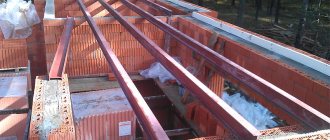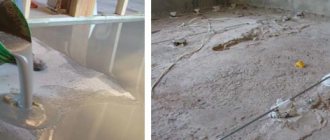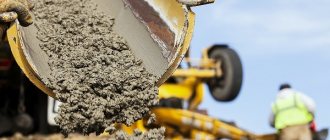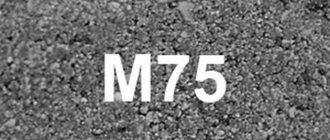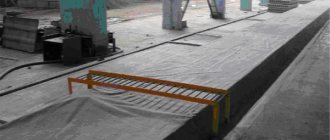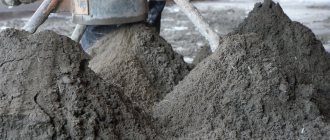An armored belt is a reinforced concrete structure that is designed to strengthen the walls of a house. This is necessary to protect the walls from loads arising under the influence of external/internal factors. External factors include wind exposure, terrain slope/hilliness, floating soil and seismic activity of the earth. The list of internal factors includes all household construction devices used in the interior decoration of the house. If you make an armored belt incorrectly, then due to these phenomena the walls will simply crack, and what’s even worse, they will corrode. In view of this, it is very important to be aware of how to make an armored belt. The types, purpose and method of installation of the armored belt will be discussed in this article.
Tools and materials
Before starting work, you should prepare the following tools/materials:
- Fittings.
- Cement.
- Sand.
- Crushed stone.
- Wire for tying reinforcement.
- Boards.
- Self-tapping screws.
- Brick.
- Shovel.
- Concrete mixer.
- Crowbar/crowbar.
- Welding machine.
To ensure that all the work you perform is done with high quality, we suggest that you familiarize yourself with the techniques for manufacturing reinforced mesh/framework and formwork.
Preparation of concrete
The order of adding components for concrete during mixing may be different.
The second option has its disadvantages: obtaining a homogeneous cement laitance (a mixture of water and cement) sometimes takes a lot of time. As a result, there is simply not enough of it to form bonds with the backfill: the cement “seizes” and the strength of the concrete also decreases.
For small volumes, concrete can be mixed by hand
Next, we’ll talk about the requirements for concrete components, their sizes and qualities.
Manufacturing of reinforcing mesh/frame
In order for the reinforced belt to be of high quality, and therefore the house to be reliable, you need to know how to properly make the reinforced mesh/frame. The connection of the reinforcement bars to each other is carried out using a knitting wire, and not a welding seam. This is due to the fact that during welding, the area near the seam being made overheats, which leads to a weakening of the strength of the reinforcement. But you can’t do without welding seams when making mesh. The middle and ends of the frame are welded, while the remaining connecting nodes are tied together.
The frame is laid in an armored belt.
The rods are fastened to fix the reinforcement in the required position when pouring concrete. For these purposes, thin wire is used; the strength of the mesh/frame does not depend on it.
For the manufacture of armored belts, only ribbed rods are used. Concrete clings to the ribs, which helps to increase the load-bearing capacity of the structure. Such a belt can work in tension.
To make a frame, take 2 wires 12 mm thick and 6 m long, while for transverse reinforcement you will need rods 10 mm thick. The transverse reinforcement should be welded in the center and edges. The rest of the rods are simply knitted. After making two meshes, hang them so that a gap is formed. Weld them from the edges and in the center. This way you will have a frame. There is no need to weld the frames to make the belt. They are laid with an overlap of 0.2–0.3 m.
Sequence of preparatory operations
For an armored belt, you can complete all stages of work with your own hands if you carefully study the technological process and purchase everything you need in a timely manner. Installation work stages include:
- Preparing for installation.
How to make formwork strong? What materials are needed? To arrange the frame, use ordinary wooden boards with a thickness of at least 40 millimeters. The width of the boards should be about 200 millimeters. Using special guide elements, it is necessary to fasten the formwork with nails to ensure rigidity. The length of the nails up to 120 millimeters allows for reliable fixation of the formwork for the armored belt. Carefully bend the protruding parts of the nails. For the reliability of the structure, guides to the capital elements of the building should be fixed.
Reinforcing belt (seismic belt) - increases the reliability of the house and prevents the appearance of cracks
Using these recommendations, you will receive high-quality formwork for the belt, which will have the necessary characteristics.
Grillage
Initially, you should determine the depth of the foundation. This parameter depends on the type of soil, the depth of its freezing, as well as the depth of groundwater. Then you should dig a trench around the perimeter of the future house. This can be done manually, which is long and tedious, or with the help of an excavator, which is quick and efficient, but entails additional costs.
After special equipment is used, the bottom and walls of the trench should be leveled to solid ground. The surface should be as hard and smooth as possible.
Now you need to form a sand cushion, the height of which should be 50–100 mm. If it is necessary to backfill sand more than 100 mm, it must be mixed with crushed stone. This activity may be necessary to level the bottom of the trench. Another way to level the bottom is to pour concrete.
Making a frame for a grillage
After filling the sand cushion, it must be compacted. To complete the task faster, pour water on the sand.
Then the reinforcement should be laid. During the construction process, under normal conditions, you need to use reinforcement of 4–5 cores, the diameter of each rod should be 10–12 mm. It is important that when pouring the grillage for the foundation, the reinforcement does not touch the base. It must be recessed in concrete. Thus, the metal will be protected from corrosion. To achieve this, the reinforcing mesh should be raised above the sand cushion, placing brick halves under it.
Grillage for a strip foundation
If you are building a house on heaving soil or where the groundwater level is high, then the grillage should be made more durable. To do this, instead of reinforcing mesh, you should use a reinforcement cage. He imagines 2 meshes consisting of 4 wires with a diameter of 12 mm. They should be laid below and above the armored belt. Granular slag is used as a base instead of a sand cushion. Its advantage over sand is that over time, granulated slag turns into concrete.
To make the mesh, a knitting wire is used rather than a welding seam.
For the grillage, M200 concrete should be used. To ensure that the filling height corresponds to the specified value, install a beacon in the trench - a metal peg equal in length to the height of the grillage. It will serve as your guide.
Pouring concrete mortar
The required strength can be ensured by following the following recommendations:
- The formwork for the armored belt is concreted using technology in one step;
- carry out work continuously;
- It is advisable to pump the solution directly into a wooden form using a concrete pump;
- pour concrete until it covers the reinforcement to a depth of 5 cm;
- it is preferable to use concrete with a grade of at least M 200;
- Air cavities that negatively affect strength are unacceptable. To eliminate this, use special vibrators;
- the use of plasticizers improves the fluidity of the mixture, reduces the concentration of water, which shortens the hardening time of concrete;
- the concrete mass must stand for 3 weeks;
- during hot periods, moisten the surfaces generously with water to prevent cracks and strengthen the hardened mortar.
Base armored belt
Before erecting walls, a basement reinforced belt should be poured onto the foundation. It must be poured along the perimeter of the building along the external walls, but this cannot be done along the internal load-bearing walls. The base armored belt serves as additional reinforcement of the structure. If you have filled the grillage with high quality, then the plinth belt can be made less durable. The height of the armored belt is 20–40 cm, concrete M200 and higher is used. The thickness of two-core reinforcing bars is 10–12 mm. The reinforcement is laid in one layer.
If you need to strengthen the base belt, then use reinforcement of greater thickness or install more conductors. Another option is to lay the reinforced mesh in 2 layers.
Formwork for the basement armored belt
The thickness of the basement and external walls is the same. It ranges from 510 to 610 mm. When pouring the base armored belt, you can do without formwork, replacing it with brickwork. To do this, you need to make half-brick masonry on both sides of the wall. You can fill the resulting void with concrete after placing reinforcement in it.
In the absence of a grillage, it is useless to make a base armored belt. Some craftsmen, having decided to save on the grillage, strengthen the base belt, using reinforcement of a larger diameter, which supposedly improves the load-bearing capacity of the house. In fact, such a decision is unreasonable.
The grillage is the foundation of the house, and the plinth belt is an addition or strengthening of the load-bearing capabilities of the reinforced belt for the foundation. The joint work of the grillage and the plinth belt guarantees a reliable foundation even on heaving soils and with a high level of groundwater.
Preparation of concrete
The order of adding components for concrete during mixing may be different.
The second option has its disadvantages: obtaining a homogeneous cement laitance (a mixture of water and cement) sometimes takes a lot of time. As a result, there is simply not enough of it to form bonds with the backfill: the cement “seizes” and the strength of the concrete also decreases.
For small volumes, concrete can be mixed by hand
Next, we’ll talk about the requirements for concrete components, their sizes and qualities.
Interfloor
An armored belt must also be made between the wall and the floor slabs. It is poured along external walls with a height of 0.2 to 0.4 m. Interfloor armored belt allows you to save on door/window lintels. They can be made small and with a minimum of reinforcement. Thus, the load on the structure will be distributed evenly.
If an armored belt is installed on walls made of poorly load-bearing material, the load from the floor slabs will be distributed evenly along the entire length of the walls, which will have a beneficial effect on their strength characteristics.
Formwork for interfloor reinforced belt
Reinforcement of the interfloor belt is performed with a mesh of ribbed reinforcing bars 10–12 mm thick in 2 cores. If the thickness of the walls varies between 510–610 mm, then double-sided brickwork can be used as formwork, as for the base belt. But at the same time, backing bricks should be used for internal masonry, and facing bricks for external masonry. In this case, the armored belt will have a width of 260 mm. If the walls are thinner, the backing brick should be laid on edge or wooden formwork should be used instead, and the facing brick should be laid on the outside in the same way as in the previous case.
Features of preparatory activities
A serious requirement when constructing a belt reinforced with steel bars is compliance with the dimensions. The width should correspond as much as possible to the thickness of the walls, representing a square section structure with a side size of at least 250 millimeters. If the construction of the building is carried out from aerated concrete, then the final row is laid with special blocks of a U-shaped configuration. This chain is a formwork for filling with concrete mortar. In a situation where the construction of a house is carried out from brick, the external contour is formed by installing bricks at half the thickness, and the internal contour is made from boards.
Under the Mauerlat
The armored belt can be poured under the Mauerlat only after the glue/mortar for masonry walls has hardened. The technology used to lay the reinforced belt on aerated concrete differs in the formwork design, but we will talk about this a little later. The production of wooden formwork is carried out according to a scheme already familiar to you. Concrete is prepared according to the following formula: 2.8 parts sand to 1 part cement and 4.8 parts crushed stone. Thus, you will get M400 concrete.
After filling, eliminate any remaining air bubbles in the mixture. To accomplish these tasks, use a construction vibrator or poke a rod into the liquid mass.
Mounting the Mauerlat
When constructing a monolithic armored belt, the rules for fastening the Mauerlat must be observed. During the installation of the reinforcement frame, vertical sections should be removed from it to the height specified in the project. The reinforcement bars should rise above the reinforced belt by the thickness of the Mauerlat + 4 cm. Through holes must be made in the beam equal to the diameter of the reinforcement, and threads should be cut at its ends. So, you will get a reliable fastening, which will give you the opportunity to carry out high-quality installation of a roof of any configuration.
Basic mistakes
When performing reinforcement of a monolithic belt, the following errors are considered the most common:
- Longitudinal reinforcement without the index “C” is weldable, connected by welding.
- The thickness of the protective layer of concrete for the reinforcement is not maintained.
- Incorrect formation of angles: presence of crossing of rods.
- The distances between structural elements are not maintained.
- Use of non-technological bent elements from reinforcement.
- Incorrect choice of fittings based on diameter, metal grade, and other characteristics.
- Knitting was performed without complying with technological requirements.
- To reinforce the armored belt I use very rusty reinforcement.
Any violation of the rules may result in a reduction in the life of the building or structure. Therefore, even minimal savings on materials can cause large financial losses in the future.
Reinforced armored belt makes it possible to strengthen building structures due to the uniform distribution of mechanical stress. Thanks to the optimal ratio of ductility and strength, it can easily withstand dynamic or static loads without loss of properties.
Reinforced belt for aerated concrete
Aerated concrete is an alternative to brick, which has high thermal insulation qualities along with low cost. Aerated concrete blocks are inferior to brick in strength. If when installing an armored belt on brick walls it is not necessary to pour concrete, since the reinforcement is laid during the laying process, then with aerated concrete things are different. How to make an armored belt on wooden formwork has already been discussed above, so in this subsection we will look at how to make a reinforced belt from U-shaped aerated concrete blocks D500. Although it is worth noting immediately that this technology is more expensive.
In this case, everything is extremely simple. Place the blocks on the wall as usual. Then reinforce their central part, and then fill it with concrete. Thus, the walls of your home will be more durable and reliable.
If you still have questions on the topic, then ask them to a specialist working on the site. If necessary, you can consult with our expert about filling the armored belt. Do you have personal experience? Share it with us and our readers, write comments on the article.
Functional purpose
The reinforced frame performs a number of important tasks:
- maintaining the contour and preventing wall deformation during soil shrinkage and earthquakes;
- leveling the structure being erected in the horizontal plane and eliminating errors made during laying;
- ensuring the rigidity of the building under construction;
- distribution of local or point forces along the supporting plane of load-bearing surfaces;
- fixation of a closed line, which is the basis for fastening the roof.
Regardless of your plans to place an attic above the first floor of the house, the next floor or the roof, remember that you need to take care of strengthening the structure!
Boards for future formwork should be located outside the wall, and not inside, that is, rest against the wall, in the masonry overlay by 2-4 centimeters
Let's sum it up
A reinforced base for the Mauerlat is more of a necessity than a luxury. The roofing structure has a fairly large impact on the walls of the house, which, although distributed evenly thanks to the Mauerlat, can negatively affect the strength of the entire building.
The creation of an armored belt is necessary in buildings made of gas and expanded clay concrete due to the fragility of these materials, in areas with high seismic activity. It is also advisable to strengthen the walls under the Mauerlat when creating heavy roofing structures.
https://www.youtube.com/watch?v=ekYYxE2pwwA
Reinforcing the upper part of the walls is not a difficult job requiring the involvement of specialists. If you follow a number of rules and involve assistants, it can be done on your own.
This will definitely interest you:
- Armopoyas (reinforced belt) Reinforced concrete beams over openings
- Monolithic strip foundation for a house made of gas silicate blocks Reinforcement of strip foundation
- How to make a roof with your own hands Rafter system Hanging rafters with your own hands
- Concrete compaction, concrete jointing
- How to calculate how many blocks are needed for a house
- Mortar for laying blocks
- Reinforcing frames: types of frames, production of reinforcing cages. Mounting rings
- How much cement is needed per cube of mortar? How much cement or glue is needed to lay a cube of blocks?
- Gas silicate blocks Storage of blocks
- Gas silicate blocks Basic misconceptions
